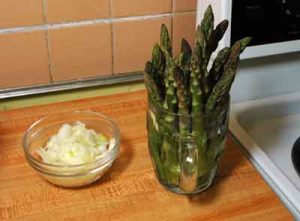Vegetable Cooking Time
By MarthaSmith
The Nose Knows
How long should asparagus cook? That questions comes up all the time for vegetables.
One infallible way to know when a vegetable is cooked is to let your nose decide. You can’t put a number of minutes on any vegetable. There are too many variables: size, age, species. For asparagus: is it fat or thin, young or old, green or white? And other variables that come with each kitchen: size of the pot, amount of water, method of cooking (boiling, steaming, etc.) Add in the time variance for altitude and it’s a guess at best when someone gives you the number of minutes to cook your vegetables.
But, if you let your nose be your guide, you’ll know the vegetable is almost done when you can smell the flavors being released. At that point, taste a sample and see if the asparagus, or whatever vegetable you’re cooking, is what you had in mind. Maybe you like your veggies al dente (to the tooth or firm). Maybe you like them soft and easy to eat (for geriatrics or babies).
When your nose alarm goes off like a kitchen timer, you should test immediately, and be ready to take your veggies off the heat, put them into a strainer and shock them with cold water to stop the cooking process and seize the color.
Now you’re thinking, ‘but then my veggies will be cold.’ You can put them in a warm serving dish, keep them is a slightly warm place, but what I do is reheat them just before serving in a bit of butter or olive oil, salt and pepper to taste. This is a place where other flavors could be added like a few cuttings of a fresh herb, but the reward really is that the vegetable is cooked to the texture you like with the least amount of flavor lost.
Another tough question: Cover on or cover off? Which veggies cook better covered and which ones like steam evaporating right out of the pan. A rule of thumb: Vegetables that grow underground, cook best with the lid on. If the veggie grows above ground, cook with the lid off. There are exceptions to every rule, of course. For example when I cook spinach, I always use a lid to keep all the residual moisture from the spinach in the pan because I don’t start with water in the bottom of the pan. Just the water that remains after cleaning the leaves. Don’t ever cook spinach in an aluminum pan or the iron in the spinach will have a reaction with the aluminum.
Good luck with this cooking method and remember, like all rules, sometimes they are meant to be broken.
